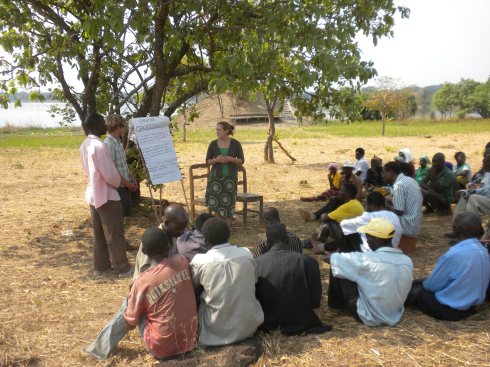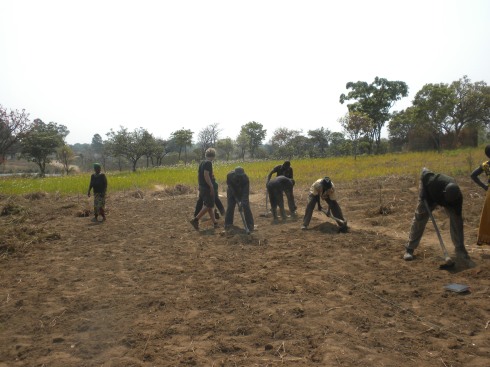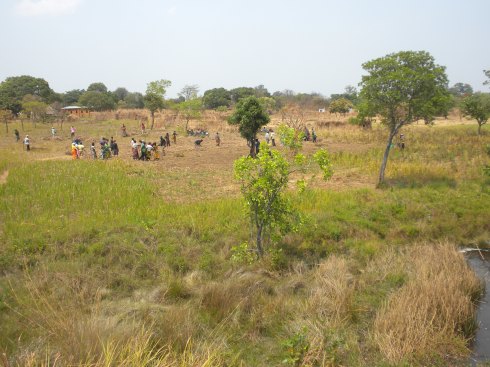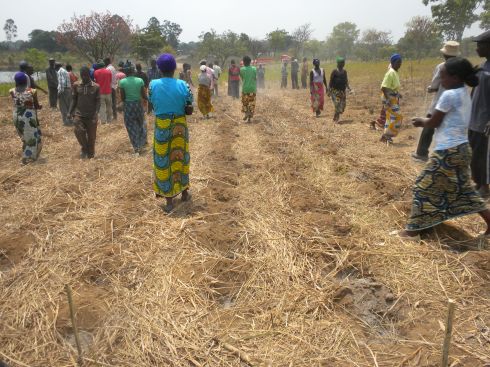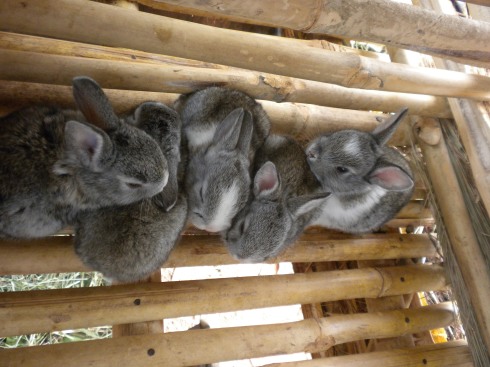You are currently browsing the tag archive for the ‘Conservation Farming in Zambia’ tag.
Sweet relief! It’s been painfully, unbelievably hot here for the past couple weeks, but the most recent few days have been so much cooler, breezy, yet still gorgeously sunny. We are in Solwezi; just finished up our quarterly reports and are now getting ready to go to Lusaka to meet up with my family. My dad and his girlfriend Meredith arrive tomorrow; my sister and her husband fly in on Saturday. It’s just a brief trip but promises to be a good one: Livingstone and Victoria Falls, and then back to the incredible McBrides Camp in Kafue National Park. Andrew and I have been in Zambia for 20 (!) months now. My sister and her husband are State Department employees in Beijing. And Dad’s in Vermont. Needless to say, our family hasn’t been reunited in some time. That alone is worth plenty of happy anticipation!I have so say that, as absurd as it may seem, I’m excited for vacation and the BEDS vacation entail. We have a poor-quality foam mattress that increasinly resembles a couple of hot dog buns, side by side. The beds at the provincial house are recycled from volunteer’s sites, so more buns abound. I consider both of us quite young and healthy, but there’s nothing like waking up after a night’s sleep on a POS mattress. I awake each morning to an orchestra of birds and roosters, the sunlight filtering in through our windows. I enjoy this for a few moments, thinking about getting up, starting a fire, and getting going with my favorite morning ritual of watching the sun rise over the garden with Andrew, on our cement love-seat veranda, cups of coffee in hand.
Then I sit up and feel the ache of my shoulders, back and neck, and feel slightly less certain the day will be as glorious as I think it will be. Every day is a combination of hauling, lifting, hoeing, biking, digging, walking, and moving, and to wake up with a sore back makes everything seem a bit less do-able.
I was hugely fortunate to be able to take a few yoga classes when we were home in May. While I do practice here in Zambia (thanks to the outdoor shelter for privacy Andrew made me), I miss the formality of arriving at a studio, spreading out my mat, waiting for the teacher to begin. A personal home practice is a gift, but so is practicing with an instructor. Anyway, at the Primary Series class I took while home at beloved Yoga Vermont, the teacher (also beloved) with whom I did my teaching certificate asked me within 10 minutes of the class starting if my lower back hurt. She’s a genius at reading bodies. I said yes. She asked why. Not wanting to be that person who talks endlessly during class, I think all I managed was something like “Arrruughhh.”
The next week and a half, though, is spring mattresses all the way. Whew!
Here’s the news from site:
Cat’s Pregnant
Dear Belly Boo has been trying to get some action for a year now. There are no other domestic cats in our area, so it seems, at last, she’s tracked down an African Wild Cat. We expect kittens at the beginning of November.

Poor thing is already huge and it’s been brutally hot the last couple weeks. She found some solace to stretch under our shaded tree nursery.
Conservation Farming Workshops
Teaching the Conservation Farming system – a series of techniques to increase soil organic matter, maximize profit and reduce soil erosion – is one of the tasks put forth to Linking Income, Food and the Environment volunteers. We had the great opportunity to lead a two-day workshop on Conservation Farming in a more populated area, maybe 10 or 15 miles from our site. The turnout – around 120 people, approximately half of whom were women, was fantastic, enormous, and motivated. Super-exciting.
On the first day, we did an afternoon-only session introducing the main concepts of Conservation Farming.

There was a question about compost: what it is, how it’s made. Luckily I frequently travel with a bag of compost in my purse. Instead of answering the question, though, I deferred to this woman, who works with a group with whom we did a composting demonstration a couple months ago, to see if she could answer it. She rocked it. I love stuff like that.
On the second day, we did a practical demonstration of preparing a demo plot. We got access to a gorgeous piece of land by the lake, which is great. I, for one, got heatstroke that day, so below are the pictures I managed before having to be taken back to town. I’m totally fine now. Andrew, on the other hand, kept his cool (haha) and did a fantastic job leading the practical. Just another reason to do Peace Corps as a couple. If one of you feels like you’re going to die during something you’ve been prepping for months, the other can carry on with the program. Hooray!

Levelling the ridges that where there – realigning planting lines against the slope rather than with it
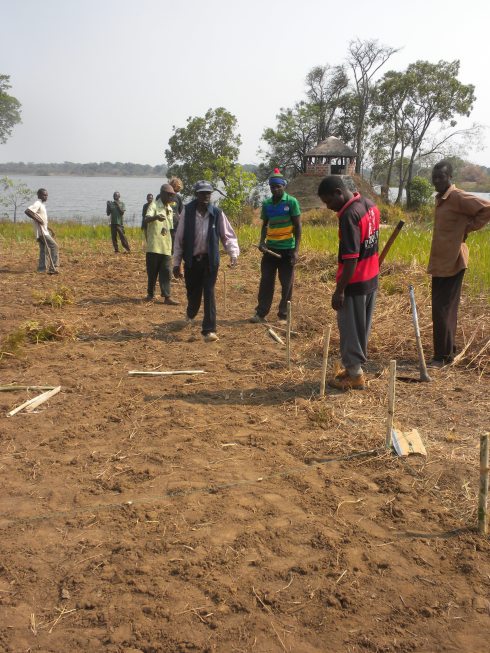
Putting posts in for spacing and slope. Strings attached to the posts have bottle caps attached at fixed spacing, to indicate where permanent planting basins will be dug. The permanent basins are a focal point of the CF system, as they reduce tillage and target input application.

Old field on the left: rows that get shifted annually run down the direction of the slope, leading to massive erosion. On the right, the team works on the new field.

Mulching to add organic matter to the soil, protect the soil from the sun’s heat, maintain a more constant temperature and moisture level, and reduce the erosion-causing impact of heavy rain. In subsequent years, crop residues and weeds from within the field will be used instead of bringing grass in from outside it.
Rabbit adorableness continues
The 10 kits are alive, healthy, and rambunctious. At nearly 3 weeks of age, their eyes are open, they are out of the nesting box, and they are hopping around.

As their eyes started to open, those stuck shut with gunk got little warm-wet-cloth eye sponge-baths.

Post-lunch, put ’em to work on our third (and final, seriously) rabbit hutch. This will be a 2-bedroom apartment for weaning rabbits while community members finish their own hutches, and fattening rabbits for our own consumption.

Current composting system under the two adult hutches. Under the left hutch, I pile up dried grass and leaves to absorb manure, urine and odor. I toss our kitchen scraps under there as well and periodically re-cover with grass and soil, and then shovel into the compost piles behind. On the right hutches, manure is funneled into basins via pretty much the same system, but then I can replace the basin with a bucket if I want to collect manure for manure tea fertilizer. Behind the hutches are three compost piles: under construction (left), partially finished (middle), and finished (right). I keep the compost covered to retain moisture.
Community Hutches Underway
We’ve had a really positive response about the rabbit project in our community, but now comes the real test: how many people will actually build hutches? We’ve been helping a couple get started, which is really exciting for us.
That’s all the news for now…vacation calls!
The news lately…
Rain is here! The first rains came in mid-October with a massive, 15-hour downpour. Since then it’s rained every few days. Farmers (and especially their wives!) in our area are extremely busy prepping their fields for planting.

Just the beginning of the 15-hour downpour. Notice the full buckets, but also note the charcoal fridge on the edge of the porch. Wet charcoal that has enough airflow will keep food cool and keep it from spoiling for at least a few days.
With rain, comes critters.
Planting agroforestry species and teaching conservation farming

The seedling in the foreground is Faidherbia albidia, known locally as msangu. It’s an acacia species that sheds its compost-like leaves at the beginning of the dry season and brings nutrients up from deep in the soil, making it ideal for planting within crops. Here is Andrew planting them in a 10×10 meter grid with one of the farmers we’re working with.
Celebrating our second anniversary! We spent our anniversary in the village. We had a meeting that morning with a gentleman interested in fish ponds at his house. He didn’t show up, as he had already left for his farm. This was the fifth meeting he’d scheduled and then bailed on, but we decided to go on a trek through the bush to try and find his farm. We weren’t successful, but enjoyed our time regardless.

Once we recognized we were way in the middle of nowhere and weren’t going to find the farm we were looking for, Andrew focused in on finding me the most bizarre flower from the bush for my anniversary bouquet.
Belly is all grown up. She disappeared for a full 24 hours a couple weeks ago. Perhaps she managed to find an African Wild Cat in the woods? There are no domestic cats in our area.
Always working in the garden and our demo plot!
It’s starting to storm and I’m afraid we’ll lose power, so that’s all for now!


